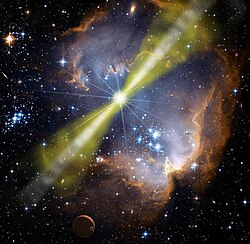Gamma-ray burst
Gamma-ray bursts (GRBs) are flashes of gamma rays from extremely energetic explosions. They have been seen in distant galaxies. They are the most luminous electromagnetic events known to occur in the universe.

Bursts can last from milliseconds to several minutes, although a typical burst lasts a few seconds. The initial burst is usually followed by a longer-lived 'afterglow' emitted at longer wavelengths (X-ray, ultraviolet, visible light, infrared and radio waves).
Most GRBs are a narrow beam of intense radiation released during a supernova, as a huge rapidly spinning star collapses to form a black hole. A subclass of GRBs (the 'short' bursts) seem to come from a different process, perhaps the merger of binary neutron stars.
The sources of most GRBs are billions of light years away from Earth. This suggests the explosions are extremely energetic: a typical burst releases as much energy in a few seconds as the Sun will in its entire 10 billion year lifetime.[1] They are very rare (a few per galaxy per million years).[2]
All observed GRBs have come from outside the Milky Way galaxy. Similar phenomena, soft gamma repeater flares, are associated with magnetars within the Milky Way. It has been suggested that a gamma-ray burst in the Milky Way could cause a mass extinction on Earth.[3] No such case is known.
History
changeGamma-ray bursts were first observed in the late 1960s by the U.S. Vela satellites, which were built to detect gamma radiation pulses emitted by nuclear weapons tested in space.
On July 2, 1967, at 14:19 UTC, the Vela 4 and Vela 3 satellites detected a flash of gamma radiation unlike any known nuclear weapons signature.[4] Uncertain what had happened but not considering the matter particularly urgent, the team at the Los Alamos Scientific Laboratory filed the data away for investigation.
By analyzing the different arrival times of the bursts as detected by different satellites, the team was able to determine rough estimates for the sky positions of sixteen bursts[4]12-16 and definitively rule out a terrestrial or solar origin. The discovery was published in 1973.[5]
Long gamma-ray bursts
changeMost observed events last longer than two seconds and are classified as long gamma-ray bursts. They have been studied in much greater detail than their short counterparts. Almost every well-studied long gamma-ray burst has been associated with a rapidly star-forming galaxy and in many cases a core-collapse supernova as well. This links long GRBs with the deaths of massive stars.[6] Long GRB afterglow observations at high redshift (great distances) also suggest GRBs originate in star-forming regions.[7] This is because observing distant galaxies is to look back in time to galaxies at an earlier stage.
Energetics
changeGamma-ray bursts are thought to be highly focused explosions, with most of the explosion energy in a narrow relativistic jet travelling at speeds over 99.995% of the speed of light.[8][9]
The approximate angular width of the jet (that is, the degree of beaming) can be estimated directly by observing "jet breaks" in afterglow light curves: a time after which the slowly-decaying afterglow begins to fade suddenly, as the jet slows down and can no longer beam its radiation so effectively.[10][11] Observations suggest significant variation in the jet angle from between 2 and 20 degrees.[12]
Because their energy is strongly beamed (very narrow), the gamma rays emitted by most bursts miss the Earth and are never detected. When a gamma-ray burst is pointed towards Earth, the focusing of its energy along a relatively narrow beam causes the burst to appear much brighter than it would have been were its energy emitted spherically. When this effect is taken into account, typical gamma-ray bursts are observed to have a true energy release of about 1044 J, or about 1/2000 of a Solar mass energy equivalent.[12]
This is comparable to the energy released in a bright type Ib/c supernova (sometimes called a 'hypernova'). Very bright supernovae have been seen at the position of some of the nearest GRBs.
References
change- ↑ Frail D.A.; et al. (2001). "Beaming in Gamma-ray bursts: evidence for a standard energy reservoir". Astrophysical Journal Letters. 562 (1): L557–L558. arXiv:astro-ph/0102282. Bibcode:2001ApJ...562L..55F. doi:10.1086/338119. S2CID 1047372.
- ↑ Podsiadlowski, Ph.; et al. (2004). "The rates of hypernovae and gamma-ray bursts: implications for their progenitors". Astrophysical Journal Letters. 607 (1): L17–L20. arXiv:astro-ph/0403399. Bibcode:2004ApJ...607L..17P. doi:10.1086/421347. S2CID 119407415.
- ↑ Melott A.L.; et al. (2004). "Did a gamma-ray burst initiate the late Ordovician mass extinction?". International Journal of Astrobiology. 3 (1): 55–61. arXiv:astro-ph/0309415. Bibcode:2004IJAsB...3...55M. doi:10.1017/S1473550404001910. S2CID 13124815.
- ↑ 4.0 4.1 Schilling, Govert (2002). Flash! The hunt for the biggest explosions in the universe. Cambridge University Press. ISBN 0-521-80053-6.
- ↑ Klebesadel R.W; Strong I.B. and Olson R.A. 1973. Observations of Gamma-ray bursts of cosmic origin. Astrophysical Journal (Letters) 182, L85 [1]
- ↑ Woosley S.E. and Bloom J.S. (2006). "The supernova gamma-ray burst connection". Annual Review of Astronomy and Astrophysics. 44 (1): 507–556. arXiv:astro-ph/0609142. Bibcode:2006ARA&A..44..507W. doi:10.1146/annurev.astro.43.072103.150558. S2CID 119338140.
- ↑ Pontzen A.; et al. (2010). "The nature of HI absorbers in GRB afterglows: clues from hydrodynamic simulations". MNRAS. 402 (3): 1523. arXiv:0909.1321. Bibcode:2010MNRAS.402.1523P. doi:10.1111/j.1365-2966.2009.16017.x. S2CID 3176299.
{{cite journal}}: CS1 maint: unflagged free DOI (link) - ↑ Rykoff E.; et al. (2009). "Looking into the fireball: ROTSE-III and Swift observations of early GRB afterglows". Astrophysical Journal. 702 (1): 489. arXiv:0904.0261. Bibcode:2009ApJ...702..489R. doi:10.1088/0004-637X/702/1/489. hdl:2152/34870. S2CID 14593280.
- ↑ Abdo A.A.; et al. (2009). "Fermi observations of high-energy Gamma-ray emission from GRB 080916C". Science. 323 (5922): 1688–93. Bibcode:2009Sci...323.1688A. doi:10.1126/science.1169101. OSTI 1357451. PMID 19228997. S2CID 7821247.
- ↑ Sari R; Piran T; Halpern J.P (1999). "Jets in Gamma-ray bursts". Astrophysical Journal Letters. 519 (1): L17–L20. arXiv:astro-ph/9903339. Bibcode:1999ApJ...519L..17S. doi:10.1086/312109. S2CID 120591941.
- ↑ Burrows D.N.; et al. (2006). "Jet breaks in short Gamma-ray bursts. II. The collimated afterglow of GRB 051221A". Astrophysical Journal. 653 (1): 468–473. arXiv:astro-ph/0604320. Bibcode:2006ApJ...653..468B. doi:10.1086/508740. S2CID 28202288.
- ↑ 12.0 12.1 Frail D.A.; et al. (2000). "A 450 day light curve of the radio afterglow of GRB 970508: fireball calorimetry". Astrophysical Journal. 537 (7): 191–204. arXiv:astro-ph/9910319. Bibcode:2000ApJ...537..191F. doi:10.1086/309024. PMID 309024. S2CID 15652654.